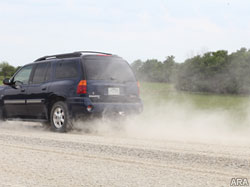
(ARA) – No one likes dust – and it’s everywhere, whether you live on a gravel road in the countryside or an urban environment. Dust accelerates wear on appliances, electronic equipment and vehicles, and it stunts the growth of your houseplants and gardens. But even more troubling is how dust may adversely affect your health, particularly if you already have breathing-related problems.
Dust is common in most areas of the world, and a small amount occurs naturally. Blowing wind erodes dirt and carries the resulting dust throughout the environment, into our homes, vehicles and lungs. Airborne particles that originate from sources such as unpaved roads, cultivated farmland and construction sites greatly increase the amount of dust in the air. “The dust that’s kicked up is called fugitive dust,” says Jason Bagley, professional engineer (PE) with Compass Minerals. “It’s a common nuisance, especially in arid areas with minimal vegetation or during periods of drought that intensify air quality and increase visibility problems.”
Because of the widespread problems caused by dust, the U.S. Environmental Protection Agency has strict standards for the amount of dust that can be present in the air, and cities and counties are required to have air quality plans in place in order to meet these standards. The dust particles are measured in microns, a measurement so small that it takes 10,000 microns to measure 1 centimeter, which is about one third of an inch.
Controlling fugitive dust is especially important because the tiny dust particles can easily enter the respiratory system, creating health problems, Bagley says. Some dust is naturally prevented from entering the respiratory system, as the human nose is designed to catch coarse particles. Humans also unconsciously expel larger dust particles that are breathed into the mouth or reach the throat. However, fine dust particles can reach much deeper into the sensitive regions of the respiratory system and have a greater potential to cause serious harm to one’s health.
Infants, children and the elderly are particularly at risk, as well as people with respiratory conditions such as asthma, allergies, bronchitis, heart disease and chronic obstructive pulmonary disease (COPD). Prolonged exposure to high dust levels, whether alone or in combination with other air pollutants, can increase medical respiratory complications, and in severe cases, cause premature death.
In order to control dust, many road crews and construction sites use a dust suppressant that works by attracting moisture from the air – especially at night when humidity tends to be higher. It keeps the dust particles damp and less able to move into the air. One product that road maintenance crews have found especially helpful is a naturally occurring product, magnesium chloride, which is evaporated from the Great Salt Lake in Utah. Produced using only the sun’s rays and wind, magnesium chloride is sold under the name DustGard.
“Road maintenance departments commonly use DustGard because it’s safe for the environment, it’s economical and it’s easy to apply,” Bagley says. He recommends that residents interested in getting more information about controlling dust with DustGard contact their local government or home owners’ association, or visit www.DustGard.com.
Courtesy of ARAcontent





